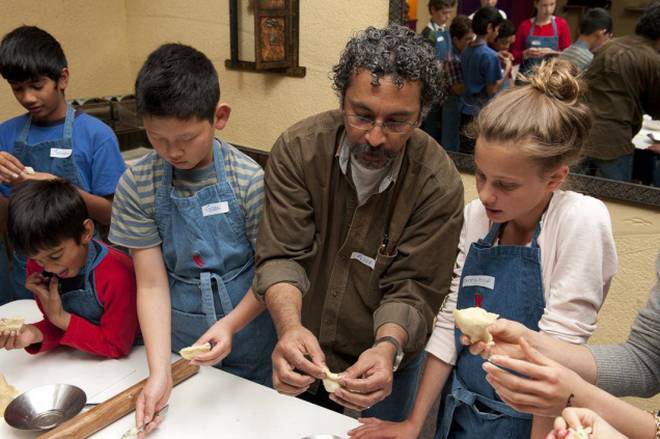By Neena Bhandari
Sydney, 20.11.2010 (The Hindu): In a country where sushi, laksa, and pizza are a gourmet’s everyday delight, Indian cuisine is attracting a growing fan base with more Australians traveling to India and Indians migrating DownUnder.
The just released India Cookbook published by Phaidon Press comes at a juncture when Australians, eager to experiment with spices and ingredients, are seeking easy to cook recipes.
The book, designed in Sydney and printed in Italy, is a collection of a 1000 recipes written by Indian author and recipe columnist, Pushpesh Pant, and is interspersed with images of dishes photographed in London.
“This book strives to present in one place the classics from different food zones of India as well as unveil unknown Cinderellas. The idea is to let the reader discover and savour the culinary diversity of this multicultural land. This should be of interest to Australians and Americans who have for long treated Mughal-Tandoori as the only mainstream cuisine of the sub-continent”, says Pant, who has dedicated the last 20 years researching and travelling the gastronomic regions of India.
Besides providing information on ingredients, techniques, utensils and how to eat to enjoy the taste and texture, the book explains the fascinating history of Indian food culture through 10 major culinary regions from Kashmir to Tamil Nadu. It includes Ayurveda, the traditional system of Hindu medicine based on the belief that all foods have different properties and a direct effect on our health and wellbeing.
Pant, who was born in Nainital and is a professor at the Jawaharlal Nehru University in Delhi says, “My mother was a brilliant scholar and a gifted cook. She has been the greatest influence and inspiration in all I do. She magically added folklore, nutritional trivia and hilarious anecdotes to even simple dishes”.
The book’s design is inspired by traditional Indian rice bags. As Frost* Creative Director and Chairman, Vince Frost says, “At the small Indian grocery near our studio in the Sydney suburb of Surry Hills, we noticed that rice came in a cotton bag with easy to carry handles and a zip and funnily enough, had the same proportions as this big book. So we thought why can’t this book come in a rice bag”.
Premier Sydney restaurants — Zaaffran and Nilgiri’s have played a vital role in catapulting Indian cuisine from traditionally a take-away option to fine dining. The book concludes with signature dishes from some of the best Indian chefs from around the world, including award-winning celebrity chef and owner of Nilgiri’s, Ajoy Joshi, who migrated to Australia in 1988 after completing his catering course from Chennai and working for the Taj Group of Hotels. He says, “Nilgiri’s was established to showcase ethnic and regional Indian food to the people of Australia and to show that our cuisine is more than Butter Chicken and Roganjosh. Over the past 14 years we have changed our menu a whopping 168 times”.
Joshi, who has also been running cooking classes for adults and young kids says, “I am a believer of the ‘process’, the destination I think takes care of itself”. The recipes he has contributed to the book are his favorite. “I would like to have them for my last supper! Each dish represents a different style of cooking and technique.”
Similarly, recipes contributed by Vikrant Kapoor, Executive Chef, and Partner at Zaaffran, are closest to his heart and have either been influenced by his mother or are his own creation or an all-time Zaaffran favorite.
Kapoor, who was born in Mumbai and formerly chef de cuisine at the Tiffin Room in Singapore’s illustrious Raffles Hotel, believes the best Indian cuisine originates not in commercial kitchens but in the ‘gharanas’ with their very own old treasured family recipes. He says, “We have taken Indian cuisine to the next level by keeping it simple and using only fresh ingredients with a touch of flair, matching it with wines and serving in a similar format to French cuisine, plated and with accompaniments. I believe this is a great time for Indian cuisine with the increased popularity of spices and other herbs not only for their flavors but also for their inherent medicinal values”.
Immigration has had a major impact on what Australians eat as the Australian social fabric is a rich tapestry of migrants from nearly 200 countries. As Television phenomenon Master Chef contestant, Jimmy Seervai, who migrated to Australia from Delhi says, “Modern Australian food now comprises of Indian elements. A few years ago, you couldn’t get coriander leaves in the supermarkets, but now you can even get curry leaves!”
While the earlier Australian diet was based upon its British and Irish heritage, by the end of the last century, Australians were experimenting and relishing Italian, Greek, Chinese, Thai, Vietnamese and Indian cuisines. In recent years, not just Indian, but the popularity of Asian cuisine has grown tremendously.
© Copyright Neena Bhandari. All rights reserved. Republication, copying or using information from neenabhandari.com content is expressly prohibited without the permission of the writer and the media outlet syndicating or publishing the article.



